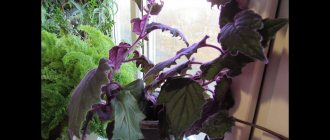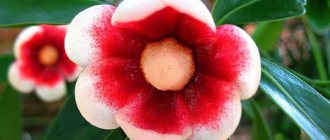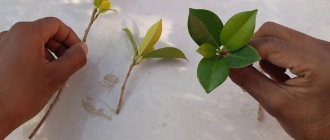Photo of a blooming Epiphyllum (Epiphyllum) is a beautifully flowering succulent from the Cactus family. In indoor culture it is grown as an hanging plant. Characterized by long, branched stems with flat or triangular edges. The flowers are large, funnel-shaped. It is also called phyllocactus.
At the base they are covered with small scales and spines. In nature it develops as an epiphyte; in indoor conditions it grows well on a substrate. Epiphyllum is native to tropical and subtropical regions of South America.
Also be sure to see how to grow prickly pear indoors.
| Average growth rate. |
| Blooms in spring and summer. |
| The plant is easy to grow indoors. |
| Perennial. |
Beneficial features
Epiphyllum oxypetalum.
Photo The fleshy fruits of phyllocactus can be eaten. Their healing properties were already known to the indigenous Indians. In folk medicine, the juice and leaves of the Dreamland epiphyllum variety are used to treat psoriasis and as an intestinal cleanser.
Epiphyllum: plant description
Epiphyllum: flower photo
The Epiphyllum flower belongs to a very large family called Cactaceae, which in turn is part of the largest branch of plants called succulents. If you want to meet Epiphyllum in the wild, you will have to go a long way, because it is found exclusively in South America. It is most often found in hot areas of Mexico. However, unfortunately, botanists and breeders have still not fully uncovered the question of the origin of this genus of plants.
According to the latest data, we can even doubt that it belongs to phyllocacti. What are phyllocacti? Phyllocacti are members of the cactus family that have leaf blades. And if you look at Epiphyllum, it would seem that there is no doubt that it is part of this subfamily.
However, according to the latest research, scientists' entire understanding may be turned upside down. However, most flower growers who do not practice their hobby as a real science will most likely not be interested in the complex nuances of the classification of this plant, and therefore we will quickly move on to another topic.
The epiphyllum flower has a huge number of species and varieties, counting which, unfortunately, is far from the easiest task, since completely different values can be obtained from different sources. However, if we try to take the arithmetic average, we get a number between thirty and forty, which is a pretty impressive result.
However, there are even more hybrid varieties of epiphyllum with unusual properties, and counting them really becomes a serious problem, and therefore, if you are afraid of difficult choices, believe me, when buying epiphyllum you have something to worry about.
However, there is no need to panic. At the end of this article, the best types and varieties of this plant are given, and therefore even those gardeners who begin to get lost even when choosing from ten species will definitely be able to find something to their liking.
As for the history of this flower, the first documented data about it dates back to 1812, when the respected botanist and breeder Adrian Haworth wrote a detailed description of it. By the way, it was he who gave this plant its name.
If we translate it from Greek, we will find that at that time people had a rather poor understanding of cacti, because epi means above, and phylum means leaf. With this name, Adrian Haworth wanted to indicate that the flower stalks of this plant grew directly on the leaves, which, of course, is not at all true, and what the scientist took for leaf blades were simply modified stems.
Speaking about these same stems, it should be noted that they are similar to the leaf blades that many cacti grow in Mexico. They have jagged edges, and needles are visible on their surface.
However, the epiphyllum still has leaves, which, however, are quite difficult to detect. They form directly under the shoots and halos, and therefore are not very noticeable. In addition, they can be confused with ordinary tissue scales coming off the stem.
A much more attractive and noticeable part of the plant, of course, are the flowers, which have an incredibly attractive delicate aroma and stunning coloring. Perhaps, to some extent, they can be compared with the buds of a water lily, especially in shape, but although they are much smaller than lilies, they are much more voluminous and lush.
Speaking of stunning coloring: it can be completely different and what color your buds will bloom depends solely on what type and variety you grow. For example, there are both bright pink and creamy yellow flowers. You can also find red and snow-white specimens.
However, unfortunately, you will never find representatives of this genus with blue or light blue flowers. By the way, despite the obvious visual resemblance to a water lily, this cactus received its name from another plant, which it, however, is also incredibly similar to. This plant is an orchid, and the name given to the epiphyllum by the people is, accordingly, cactus-orchid.
Of course, where there are flowers, there are fruits, and the epiphyllum, of course, has them. However, in order for the flowers to turn into them, the plant must be very well pollinated, which, as you understand, is completely impossible in a house or apartment, and therefore the likelihood that your cactus will ever develop fruits is extremely extremely small.
However, we will still tell you about the fruits of epiphyllum, since they are quite interesting and unusual. In size they can be compared to a rather weighty plum, and on their surface, as well as on the surface of modified stems, small spines can be found. The color of these small epiphyllum fruits is most often dark green, however, depending on the degree of ripeness, it can change to purple, making the epiphyllum fruit even more similar to a prickly plum.
Unlike the fruits of a huge variety of domestic plants, these are edible and some claim that they are very tasty and somewhat similar to pineapples.
Features of growing at home. Briefly
Epiphyllum is grown quite simply at home:
| Temperature | Room temperature in summer, +13-15° in winter. |
| Air humidity | Needs periodic spraying. |
| Lighting | Bright, diffused, without direct sunlight. |
| Watering | Abundant in summer, 1-2 times a month in winter. |
| Priming | Light, fertile with mandatory drainage. |
| Feeding and fertilizer | During the period of intensive growth, once every 2 weeks. |
| Transfer | As it grows in the spring. |
| Reproduction | Cuttings and sowing seeds. |
| Features of cultivation | During the flowering period, the plant should not be rotated. |
Spotted stems and other problems
Table: correcting care errors and saving and treating diseases
| Problem | Cause | Elimination |
| Epiphyllum stems wither | Root rotting due to waterlogging of the soil: most likely, the cactus was flooded | Reduce watering, replant the plant, removing rotten roots |
| The buds appeared but fell off | Moving the plant or excessively bright light | Do not disturb the plant, if it was not possible to achieve flowering, remove the aged stems by the next season, they are triangular in shape |
| The tips of the shoots dry out, and the stems are covered with ring-shaped spots, similar to cork wood | Fungal or viral infection | The plant cannot be treated. To prevent the infection from spreading, the flower is destroyed |
Epiphyllums do not suffer much from pests. But this flower still has enemies. Therefore, inspect the plant more often to identify pests and begin to fight them in a timely manner.
Table: how to save a forest cactus from pests
| Pest | Sign | Way to fight |
| Spider mite | Cobwebs on stems |
|
| Aphid | Insects are visible on the flower | Purchase aphid repellent from a specialty store and follow the instructions. |
| Mealybug | Cotton-like coating on stems |
|
| Shchitovka | Brown plaques on stems |
|
| Slugs | Insects leave behind silvery trails of dried mucus | Place granules of Thunder or Meta preparations under the plants. |
Epiphyllum: care at home. Details
Caring for epiphyllum at home should be carried out in compliance with certain rules.
Bloom
The flowering period of leaf cactus occurs at the end of spring - beginning of summer. Mature, well-developed plants are abundantly covered with large, fragrant flowers of white, red or pink. Each flower lasts about 5 days.
How to stimulate flowering
To stimulate the flowering of epiphyllum, all old shoots are cut out on the plant in the fall. If it was kept at high temperatures in winter, another pruning is carried out in the spring.
During pruning, all thin and elongated shoots are removed.
Temperature
Epiphyllum is grown at a temperature of +23-25°. With the beginning of autumn, the temperature must be reduced to +15°. It winters well even at +5°, so if you have an insulated loggia or veranda, you can take it there.
Spraying
Homemade epiphyllum adapts perfectly to the ambient air humidity. But if the temperature in the room rises above +26°, the plant must be sprayed daily. Spraying is also necessary during the period of intensive growth of leaf mass and during flowering.
Lighting
Bright but diffuse lighting is necessary. Windows facing east or west are best suited for growing it. You can grow a succulent from the north side, but in this case the flowering will be weak.
In order for the bush to develop evenly, the pot with the plant must be turned periodically. However, this should not be done once buds begin to form and during flowering. All the flowers may simply fall off.
Watering
In summer, water regularly and abundantly. But at the same time, the soil surface should dry out a little between waterings. In winter, the plant is watered very rarely. Usually 1-2 times a month is enough. When the temperature drops to +5°, watering is stopped completely.
Pot
The epiphyllum plant is grown indoors in spacious plastic or ceramic containers. The main thing is that drainage holes are made in their bottom. Despite the fact that it loves moisture, stagnation of moisture is destructive for it.
Priming
To grow epiphyllum, light, fertile soil is used. To compose the soil mixture, humus, turf soil and sand are used, they are taken in equal proportions. An industrial substrate for cacti is also suitable for growing. Before use, it is mixed with peat in a 1:1 ratio.
Feeding and fertilizer
During the period of intensive growth and during flowering, feed every 2 weeks.
For fertilizing, choose fertilizers with a high content of phosphorus and potassium; nitrogen is harmful to it.
Transfer
Epiphyllum is transplanted after the end of the flowering period. The plant is first allowed to rest for a month and only then replanting begins. Young, intensively growing specimens are replanted annually. Older plants as they grow, every 2-3 years.
Trimming
Epiphyllum needs constant pruning. It is carried out in the fall, before the start of the dormant period. All woody, crooked and damaged shoots are removed from the plant. Moderation should be observed when pruning. Buds are formed only on last year's shoots.
Rest period
For abundant flowering, epiphyllum requires a period of rest. Plants kept warm also bloom, but not as long and profusely. The dormant period lasts from late October to February.
During this period they are kept at +10-12°.
How does epiphyllum reproduce?
There are several ways to propagate epiphyllum.
Germination of seeds
To germinate seeds, you need to wait until the epiphyllum blooms, which produces the first flowers only by the 5th year of life. After successful pollination, fruits are formed in which the seed will ripen. It is sown in nutritious soil and covered with glass.
In order to get seedlings, the temperature in the room is maintained at least 23 °C, the pot is placed near a window with good lighting. Every day the greenhouse is ventilated for several hours and watered if necessary. After the emergence of seedlings, the shelters are removed and the temperature regime is maintained for further growth of the stems.
Rooting cuttings
This is the easiest and most effective way to propagate a plant. Select healthy stems of an adult bush and cut them into pieces 10 cm long. Place the cuttings in a dark place for 2 weeks until the cuts begin to shrink. Then the cuttings are planted in a shallow tray with a nutritious moist mixture. There should be a drain hole at the bottom. Cuttings can be rooted in light soil that is well-ventilated.
Propagation by cuttings is the easiest way
Dividing the bush
An adult bush has shoots with its own roots; it can be divided into several parts. This procedure is carried out in the summer, after the flowers fall. Carefully remove the bush from the pot, divide the rhizome into segments and transplant the bushes into a prepared container with a nutrient mixture. At first, watering is moderate; you need to monitor how the seedlings take root in the new place.
Growing epiphyllum from seeds
Like the vast majority of other succulents, it is easy to grow from seed. They are sown in the soil mixture without subsequent incorporation. To maintain high humidity, planting containers are covered with film and kept at a temperature of +25°. Crops must be ventilated periodically, removing accumulated condensate.
Shoots appear in 2-3 weeks. After this, the film is immediately removed. First, the seedlings acquire a faceted shape, which is not typical for epiphyllum; they will become flat after 3-4 months of cultivation. Plants grown from seeds bloom after 4-5 years.
Leaves, flowers and fruits of epiphyllum
A cactus called epiphyllum is a beautiful flowering plant with large leaf-like shoots. The stems are long, wide, belt-shaped or triangular, with a pronounced central vein, without thorns, fleshy, with jagged edges. The leaves are formed as small scales and are located in the recesses under the areoles.
Blooms in spring and summer. The flowers are fragrant, large, very beautiful, with satin petals, come in all colors of the rainbow, the flower tube is long. For these unsurpassed characteristics, the plant is popularly called the “orchid cactus.”
With artificial cross-pollination, the epiphyllum produces fruits. They are quite large - like a plum. The outer surface is yellowish-green or purple (this is influenced by the color of the flowers), and is often covered with needles. The fruits are distinguished by edible pulp - juicy, aromatic, sweetish, slightly reminiscent in taste of a mixture of pineapple and strawberries. Inside there are a small number of black seeds, the length of which reaches about 2 mm.
How the fruits produced by the epiphyllum flower look from the outside and in cross-section, look at the photos below:
Propagation of epiphyllum by cuttings
The tops of well-developed last year's shoots are suitable for propagation. Cuttings 10-15 cm long are cut from them. Their base must be given a wedge-shaped shape. After this, the cuttings are dried for 2-3 days until a characteristic glassy crust forms on the cut. For planting, use clean sand or soil for succulents.
Cuttings are planted vertically to a depth of 1 cm. Plants grown from cuttings bloom the next year.
Cuttings can also be rooted above water. To do this, after drying, they are fixed in a container so that their lower part is as close as possible to the surface of the water. After the formation of root primordia, the cuttings are immediately planted in the substrate.
Signs and superstitions
Since Epiphyllum is the same cactus, all folk signs and superstitions apply to it. Here are some of them:
- If the cactus has bloomed, then according to popular wisdom, you should expect an addition to the family or material wealth, and lonely people will find their soul mate.
- A cactus in the house protects from uninvited guests, evil spirits, the evil eye, damage and bad energy.
- Giving a cactus means separation. People believe that if you receive a cactus as a gift, you can part with your beloved.
- Lonely girls who bring a cactus into the house drive away their happiness.
Whether to believe in these signs or not is something everyone can decide for themselves, but among people opinions are divided and for some everything coincided, while for others it was the other way around. That's it.
That's all, beautiful cacti to you and good luck!
Diseases and pests
Flower growers very often face a number of problems:
- Epiphyllum does not bloom. The flowering period may be absent due to non-compliance with wintering conditions, lack of lighting, or excess nitrogen in the soil. It is necessary to adjust the conditions of maintenance, providing the plant with proper wintering with a sufficient level of illumination.
- The buds have fallen. The problem occurs when turning or moving the plant.
- Black spots on the leaves appear as a result of the development of black rot. The affected plant must be treated with a fungicide, for example, Fundazol.
- Light brown spots on the leaves indicate the development of a fungal infection. Fungicides are also used for treatment.
- Yellow-red spots on the leaves are the result of water entering the sun when watering.
- The roots rot. The problem occurs when there is excessive watering and lack of drainage. To save the plant, an emergency transplant is carried out with the removal of rotten roots.
- Shoots wrinkle and lose turgor with a lack of moisture and exposure to the sun. The plant must be provided with sufficient watering by moving the pot to a place with diffused lighting.
- Epiphyllum leaves are cracking . When using fertilizing with nitrogen, leaf blades may crack. Fertilizer application must be temporarily stopped.
The most common pests are mealybugs, spider mites, and thrips. To combat them, special insecticides are used.
Possible difficulties
If not maintained properly, epiphyllum suffers from fungal diseases (black rot, anthracnose, fusarium, leaf rust). All these diseases are characterized by slower growth, the appearance of weeping spots on the leaves and trunk of various colors, as well as an unpleasant, putrid odor. It is necessary to replant the diseased plant, trim off the damaged areas and treat them with crushed charcoal. Fungicide is also sprayed.
The most common parasites for epiphyllum are spider mites, aphids, scale insects and mealybugs. They are combated by bathing and treating with insecticides (Confidor, Mospilan, Aktara, Biotlin).
Types of home epiphyllum with photos and names
The following types are most often used in indoor floriculture:
Epiphyllum anguliger or angular Epiphyllum anguliger
A highly branched species with rounded or triangular stems that become woody at the base. The length of the stems can reach 1 meter or more. The flowers are medium-sized and bright red.
Epiphyllum oxypetalum
The species is characterized by large plants up to 3 meters high. The stems are flat with wavy edges. The flowers are very large, their average diameter is 15 cm or more.
Epiphyllum hookeri
Characterized by long, cascading stems and white flowers. It grows naturally in Cuba.
Epiphyllum crenatum
The stems are bluish-green in color, up to 80 cm long, with carved edges. The diameter of the flowers is about 15 cm. Their color varies depending on the variety.
Epiphyllum phyllanthus Epiphyllum phyllanthus
It grows naturally in South America. The length of the shoots reaches 1 meter. The flowers are pink, very large.
Guatemalan epiphyllum Epiphyllum guatemalense
The stems consist of parts shaped like oak leaves. The size of each individual link is about 5 cm. The flowers can be pink, red or white.
Epiphyllum ackermanii
The stems are flat, drooping with jagged shoots at the base. The flowers are bright red and sit on a characteristic thin stalk.
Epiphyllum Laui Epiphyllum laui
A species with large stems covered with very thin needles up to 4 mm long. The flowers are milky or creamy and open only in the evening. They stay on the plant for about 2 days.
What is an epiphyllum flower?
epiphyllum
Descriptive characteristics
Epiphyllum has many drooping, flat green stems. They are segmented and sometimes resemble ribbons. Sometimes the edges of the stems are covered with large teeth with sparse areoles, where small spines grow. Over the years, the stems become lignified, their shapes become round in cross-section, and the base is covered with a rich brown bark. The formation of large flowers and bright colors occurs at the tops of the shoots. They can be white, lilac, pink, yellow, red and orange. The diameter of one flower is about 15 centimeters. As soon as they begin to bloom, they emit an incredible aroma that can fill the entire room. Close relatives of the epiphyllum are phyllocacti, with which they can form plants of hybrid forms.
The length of the shoots of this plant can be from 1 meter to 3 meters.
Bloom
Epiphyllum begins to bloom in the last month of spring, but there are also species that can bloom regardless of the time of year. One areola produces one very attractive flower, pleasing to the eye for 5 days. The appearance of buds on shoots with a flat shape is especially common. If you create suitable conditions for the plant and properly care for it, the plant can bloom twice a season.
Rules for growing and pruning epiphyllum
epiphyllum: photo
It will be very easy to care for epiphyllum, since the plant is distinguished by its unpretentiousness and it will only need modest fertilizing and rare watering. It will grow comfortably if there is a lot of space for this and if shoots that are too long are trimmed.
In adulthood, plants need thinning, during which old shoots with signs of damage should be removed.
Please note that you should not move the plant when buds begin to form or flowering begins, as this will cause the buds to drop.
Only young and flat branches produce flowers, so the rest, old ones, can be removed without hesitation. When pruning, you must use clean and sharp tools. All cuts must be immediately treated with charcoal.
As soon as the weather becomes consistently warm and before the beginning of autumn, the plants can be taken out into the garden, balcony or terrace. This must be done gradually, allowing the plant to get used to it. You need to start with a few hours a day, and every day increase the time to a whole day. The plant should be in a place protected from rain, winds and drafts. Also, plants should not be exposed to direct sunlight.
When the plant goes into vegetative rest, the period October-March, growth stops, which is quite natural. The formation of new shoots occurs in the period April-August.
Vertical gardening is possible with the help of epiphyllum. To do this, you need to use a support for its long stems and direct the branches towards it. You can also grow them in hanging pots, where they will look spectacular, or grow them as an ampel flower, whose branches will hang beautifully from the pot.
Transplantation - only as a last resort
Epiphyllum grows quite quickly. And its stems do not bulge very neatly in all directions. He seems to have outgrown his potty. But this is not so, and do not rush to replant the plant.
A large pot is not a plus, but a minus for epiphyllum: the cactus cannot absorb large amounts of moisture, and the soil will turn sour in a large pot. Here it is not far from rotting of the roots.
Another argument against transplanting epiphyllum: this plant blooms profusely only in a cramped pot where the roots can barely fit. So replant the epiphyllum only in extreme cases, if the plant is sick, if the soil turns sour or the pot cannot withstand the pressure of the roots (this also happens). Replant an adult plant when it has completely bloomed. Young epiphyllums - in spring.
Soil for epiphyllum is a ready-made mixture for cacti and succulents, to which you should add a quarter of the volume of peat soil, or a substrate that you can prepare yourself . To 4 parts of leaf and turf soil, add 1 part of peat and sand, and another half measure of charcoal.
Organic fertilizers in small quantities, for example, dried mullein, are welcome as additives when planting.
When the transplant is ripe, follow this procedure:
- On the eve of transplantation, two days before, stop watering the epiphyllum. In this way, you will ensure that the earthen lump disintegrates when the plant is removed. The old soil should remain in the old pot.
- Choose a pot that is wide but not deep and has good drainage holes.
The roots of the epiphyllum are located near the surface. The pot should be small enough for the roots to fill it almost entirely.
- Provide a drainage layer, about 2 cm, for example, expanded clay.
- Add a layer of prepared soil and compact it lightly.
- Remove rotten and damaged cactus roots. To prevent diseases, it is useful to powder the roots of epiphyllum with crushed charcoal.
- Place the plant in the center of the pot and cover it with soil, tamp it down and water lightly.
- After transplanting the plant, give it a rest, water it moderately, remove it from bright light, away from the window.
Video: mixing the optimal soil for planting phyllocactus
Varieties: almost any flowers, except blue
Two dozen species of epiphyllum were created by nature itself. Breeders increased their number 10 times. They have developed hybrid varieties that can be grown traditionally on a windowsill and hung in pots as hanging plants. But special attention goes to the flowers of epiphyllum. They come in a wide variety of colors, literally the entire rainbow spectrum, except blue.
Particularly popular among amateur gardeners are:
- epiphyllum angularis,
- epiphyllum phyllanthus,
- epiphyllum hooker,
- epiphyllum serrated,
- Epiphyllum Ackermann,
- Epiphyllum Just Pr.
Photo gallery: popular varieties of epiphyllum with different flower colors
This showy pink flower is a hybrid variety of Epiphyllum Just Pru
Epiphyllum hooker has snow-white flowers
The flower of the Ackermann epiphyllum can be red or white, but the most beautiful is yellow.
Epiphyllum phyllanthus is a large plant, but the flower is up to 18 cm
Hybrid Wendy-2 - minimal greenery and a huge flower
Ephiphyllum angularis has a very impressive stem shape
Epiphyllum serratus has serrated stems











